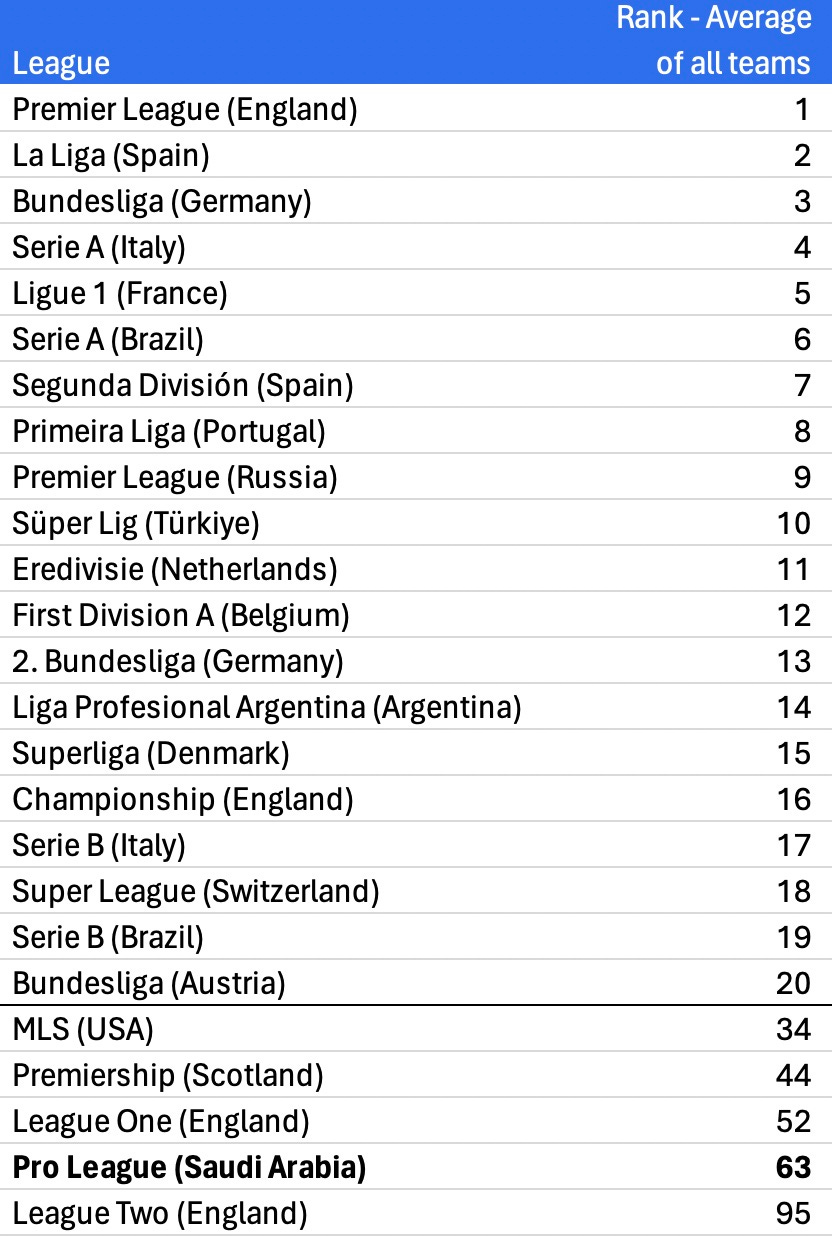The data that shows Jordan Henderson was playing at a level comparable with Notts County in Saudi Arabia
More Mailbag!
Welcome to the second part of the Mailbag. If you missed me answering questions about Manchester United’s incoming CEO and the extent of his links to Manchester City’s Financial Fair Play case, Paul Pogba’s doping suspension and my favourite sports books, you might want to catch up on that here.
But we have so much more to talk about. Onto the questions…
A former Germany midfielder writes…
A question from Thomas Hitzlsperger. (Yes, that one, the former Aston Villa and Germany midfielder, aka Der Hammer). He writes:
Nick, do you have any insight into the objective quality of the Saudi Pro League compared to the big leagues of Europe and the rest of the world? Jordan Henderson has just left Al-Ettifaq and I wonder if it’s simply because the football was way below his level? In case he ever comes to L’Escargot for lunch or dinner one day, I should know more about his spell in Saudi. The meal will be on me! But what does the data say? Thanks. Thomas.
Nick Harris: I’d love to join you both for dinner and hear about it, Hitz, if he takes you up on your offer! I’ll have the lobster bisque to start, please, followed by a steak with dauphinoise and some roast broccoli.
Getting back to your Q, on the data front, you’re right. Despite the influx of some high-profile players including Cristiano Ronaldo, Neymar, Roberto Firminio, Sadio Mané and Karim Benzema, the quality of the 18-team league is, overall, pretty bad. And the crowds at some matches are pitiful. Henderson played in one away game last October (a defeat) where there were only 669 fans.
For the data, I contacted Omar Chaudhuri, the chief intelligence officer at the analytics firm Twenty First Group, to tell me where the Saudi Pro League ranks in world football by quality of league.
The Twenty First Group advises teams and leagues across many sports about performance, and we’ll get to their methodology in a moment. First, here are the world’s top 20 most competitive (and “best”) football leagues, plus assorted others, and the Saudi Pro League is in 63rd place, way below North America’s MLS and Scotland’s Premiership and even below England’s League One.
As for the team Jordan Henderson was recently captaining, Al-Ettifaq, Omar says: “Their level is roughly the same as a weak League One team like Cheltenham Town, or a good League Two team like Notts County.”
I’ll hand over now to Omar for the methodology explanation and other notes.
We have developed two models to assess the quality of teams and leagues. The first model looks at on-field results and underlying performance, in which we rank over 7,000 teams globally in one big league table.
The model uses a machine-learning algorithm to work out the quality of teams within a league — this is obviously closely correlated with the league table — and then looks at international competitions like each confederation's Champions League, and the Club World Cup, to assess the relative quality of different leagues.
So although Burnley have not played Werder Bremen this season, we can assess where these two rank based on the fact that Man City have played Leipzig, and we know how good Burnley are relative to Man City, and Werder Bremen relative to Leipzig.
The second model looks at the quality of players within each team and league. Players are assessed on the level at which they are playing within the 7,000-team league, and their contribution to their team.
Our Player Model rates more than 100,000 players and enables us to compare the squads of teams in different corners of the globe. Separating the quality of players on the pitch from the actual performance levels of teams is important; we all know that great players do not necessarily make great teams, and evaluating how well those teams are actually performing is probably a truer guide as to the quality of a league.
The Saudi Pro League is the 63rd most competitive league in the world according to our rankings, which are based on analysis of the average team within each league.
This places the league on a par with the Bulgarian and Peruvian top divisions, and the Belgian second division.
The Pro League has not improved its ranking much since the summer spending spree. This is because Saudi club results in international competitions have not improved significantly.
In the AFC Champions League, Ronaldo's Al Nassr scraped through a qualifying round and their wins in the group stage were narrow. Neymar's Al Hilal needed a 100th-minute equaliser against the third-best team from Uzbekistan in their first match. Al Itthad lost to an Iraqi team and also lost 3-1 at home to Al Ahly in the Club World Cup. In recent seasons, Saudi teams reached the latter stages and even won the AFC Champions League; with their new talent you would expect more impressive results.
There is, of course, variation within the Pro League. Our model rates Al Hilal as the 154th best team in the world, which puts them only a few places behind Luton Town (145th). While at the bottom, Al Hazem are ranked 3,476th in the world, which would make them a good National League team (Boreham Wood are 3,528th in our rankings).
If we take just the best eight teams in each league, the Saudi Pro League jumps from 63rd to 49th, and if we take the best four teams — which happens to be the PIF-owned teams — they're 39th in the world, but still below Scotland's best four teams.
Thank you, Omar. To summarise: whatever the reason Henderson left Saudi Arabia, the Pro League is way beneath him, even at 33.

Farewell to the Golden Era
New subscriber Rosie Dart emailed to say:
Roger Federer is retired and Rafa Nadal is ailing. Andy Murray is perhaps in his last year on the circuit, and Novak Djokovic is closer to 40 than 30. As a lifelong tennis fan, the era of these four, an era that also had Roddick and Del Potro, feels like tennis’s most golden period ever, at least in the men’s game. Are there any stats that would support that?
NH: Hi Rosie, we don’t need stats to know that era is coming to a close. But your question, combined with Djokovic’s defeat at the Australian Open, got me thinking. What I can give you is a case that argues, with lots of data, that the era that is now in its final stage was indeed the peak of the Open era. And the peak-within-the-peak came in 2012, at its absolute zenith at the end of that year’s Australian Open – exactly 12 years ago.
I’m going to post that later today – stay tuned.
Substack v Legacy Media
John P asks:
What will be the biggest differences covering sport on Substack vs legacy media?
NH: Hi John and thanks for becoming a paying subscriber in the first week. I’ve been humbled and delighted to have so many people signing up, paid or otherwise, and it will make a huge impact on the work I do. The biggest difference is I’m entirely in control of my own destiny and my own choices of what to cover, and when, and how.
I’ll be able to write as often as I like, to the lengths I like. There will be no top-down editorial diktats. And I’ll be able to make my own decisions on what is and isn’t legally safe to report. There will be no external agendas, aside from readers telling me what they want me to cover. I’ll sink or swim on the quality of my work.
Premflix and the Inevitable End of the 3pm Blackout
John Vesey writes:
Would definitely be interested in your views on the 3pm blackout and what you think the best (or best-of-the-worst) options of what the future could hold there?
NH: Thanks for the question, John. I think the 3pm blackout is an anachronism that will come to an end within a generation and possibly much, much sooner. For readers outside the UK, this term refers to an agreement that no games within British professional football are shown live on TV inside the UK between 3pm and 5pm on Saturdays.
This stretches back to the 1960s, when Burnley’s chairman Bob Lord convinced the Football League that screening matches on Saturday afternoon would hugely damage attendances at live games.
When a Premflix channel becomes a reality, there will be no 3pm blackout
I could write 1,000 words and just about scrape the surface of this one, but suffice to say: first, crowds in the Premier League and Football League have never been higher, at a time when there is more football on TV than ever before. Second, match-going fans are match-going fans because of the match-day experience: mates, family, pub, atmosphere. The vast majority won’t swap that for TV and that’s even more true for fans who travel away. Third, it’s ridiculous that someone in Calais can watch every single Premier League game live at 3pm on Saturday and someone who lives in Dover can’t. Not legally, anyway. And fourth, increasingly over time clubs will want to own and have control over all of their games, in all territories. At the point when a PremFlix channel becomes reality, there will be no 3pm blackout.






Nick, delighted to have you on substack. Big fan of your work for awhile. These mailbag posts are quickly becoming must-reads (along with your other critical reporting). Just wanted to say thank you!
Is it just UK football that is banned at 3pm Saturday? Or all football?